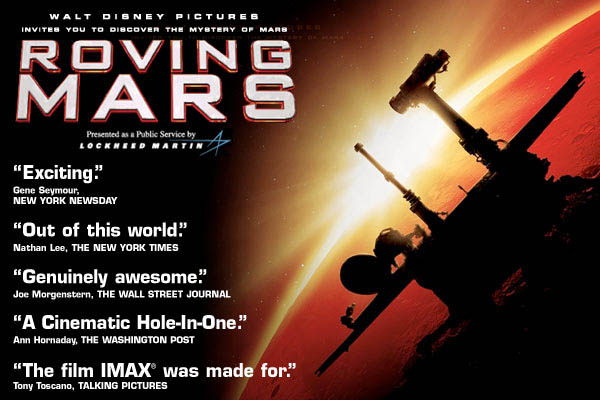


|
Your Ticket To Mars John Tierney January 28, 2006 Op-Ed
There are three reasons to rush to see "Roving Mars": 1. It's the best Imax® movie ever. 2. You will be one of the first humans to know exactly what you'd see joy riding across Mars. 3. If the box-office gross per screen is high enough on this opening weekend, you could see someone really joy riding on Mars before you die. I realize you may be dubious. In the hierarchy of cinematic praise, "the best Imax® movie" may sound to you like "the best global-warming documentary starring Al Gore." You have every right to be skeptical of a drama starring NASA engineers, science geeks and two geologists that are literally robotic. But trust me, this is not some dutiful NASA documentary on man's endless quest for knowledge. It's a Disney film directed by George Butler, who made Arnold Schwarzenegger famous with the "Pumping Iron" documentary. Its producer, Frank Marshall, has done a range of films that include "Raiders of the Lost Ark" and "The Color Purple." It's got music composed by Philip Glass. Most important, it's got the three elements that Butler demands in his films: story, story, story. Until now, the public has been bored by Mars exploration because it's been conducted by NASA as a scientific quest. The result is a Catch-22: NASA needs enormous public interest to get the money to send a human to Mars, but the public won't get interested as long as NASA is in charge. It can't tell a good enough story. It doesn't have the flair of Ernest Shackleton, the explorer featured in one of Butler's previous films, "The Endurance." Shackleton went to the Antarctic a century ago, which seemed as remote and as useless to humans as Mars does today. Instead of trying to persuade taxpayers to foot the bill, he financed his expeditions through books, lectures, photographs and the new medium of the motion picture. To get to Mars anytime soon, we need a modern Shackleton, someone who can enthrall the public (and a few wealthy patrons). The potential revenues are enormous because a private adventurer can take the kind of risks that Congress would never allow NASA to take - and the more dangerous the trip, the more lucrative the story. When the ice crushed Shackleton's ship, the Endurance, he turned the failed mission into a best seller. Unfortunately for Butler, nobody in "Roving Mars" is in danger of death except the robots. But the film still has the basic dramatic elements of the explornography genre - a bunch of zealots stumbling to a godforsaken place - because Butler focuses on the humans as they struggle to build two machines that can survive the trip to Mars. When the first rover, Spirit, swathed in air bags, finally descends on Mars, the sight is astonishing: you see what looks like a bundle of giant tennis balls bouncing across the red landscape. But the most dramatic shots are of the anxious humans back on Earth as the minutes tick by without any signal from their robot child. The scenes on Mars are mostly computer-generated footage, but they're meticulously based on Imax®-quality photographs and other data from the rovers. When Spirit lands, the bounces and spins you see are exactly the way it moved. When it traverses a crater, the terrain is precisely what its camera photographed. Steve Squyres, the chief scientist for the mission, says he was floored by the movie because it was the first time he really saw Mars. He endowed his robots with 20/20 vision, and it takes an Imax® screen to recreate that sight. But as much as he loves the movie and his robots, he says there's no substitute for sending a human to Mars. "If there's life on Mars, it's probably hundreds of meters below the surface, and it would be very hard to drill that deep without humans on the scene," Squyres told me. "A human can do in two minutes a job that takes a robot four days. We need humans on Mars both to explore better and to inspire people back on Earth." He and Butler hope the movie will inspire schoolchildren today to become the first humans on Mars. I have a more immediate hope: that it generates enough box-office revenue to persuade an adventure marketer like Shackleton to try for Mars right away. You won't just be buying a ticket to "Roving Mars." Think of it as a small down payment for an even better story. Reprinted with permission.
|